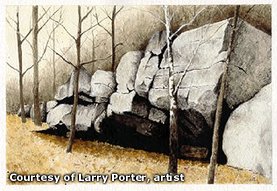|
Indians Before Europeans
Academic Perspectives by George Sabo III
Ice Age Migrations: American Indian ancestors migrated from Asia into North America during the last Ice Age (called the Pleistocene epoch) some time after 28,000 B.C. These people were hunters and gatherers who knew how to live in cold, treeless environments. Several migrations into North America took place, following overland and maritime routes. By 11,500 B.C. these migrations produced several lineages ancestral to modern American Indians. Paleoindians: Archeologists use the term Paleoindian to refer to the earliest Ice Age hunters in the Americas. A distinctive Paleoindian culture, called the Clovis culture, developed in parts of modern-day Canada, the United States, and Mexico around 11,500 B.C. Clovis people developed a unique way of life that included hunting mammoths, mastodons, and other large Ice Age mammals. Their way of life persisted for about a thousand years, until the waning centuries of the last Ice Age. Dalton: Warmer climates developing after 11,500 B.C. brought an end to Pleistocene conditions and gave rise to the Holocene epoch that continues to this day. North American environments changed in many ways, bringing extinction to mammoths, mastodons, and other large Ice Age mammals. In Arkansas and other parts of the South, Clovis culture developed into the Dalton culture around 8,500 B.C. Dalton people settled down into regional territories where they hunted deer and other animals and collected a variety of plant foods. Archaic: Diverse Archaic Indian cultures developed out of the Dalton culture in Arkansas and the South, beginning around 8,000 B.C. Many communities settled down in river valley camps occupied year-round. Men, women, and children traveled from these camps to fish, hunt animals, and collect wild plant foods. Selective harvest of several plant species led to their domestication beginning around 3,000 B.C. Gardening became a new food-producing strategy. Some Archaic communities belonged to extensive trade networks and constructed North America’s first large-scale earthworks. Woodland: Population increases, greater dependence on gardening with the addition of corn (domesticated in Mexico several thousands of years before it entered the Southeast), and the development of fired-clay pottery and the bow and arrow led to settled village life during the Woodland period, from 600 B.C. to A.D. 900. New forms of leadership emerged along with ceremonial activities that included the construction of burial mounds to commemorate the deaths of honored community members. Woodland Indians also built large earthworks in the shapes of animals, and modified the landscape with geometric mounds and earthworks oriented to seasonal solar and lunar positions. Mississippian: Large-scale agriculture and continued population growth resulted in the emergence of large, highly organized communities beginning around 900 A.D. Some towns in the Mississippi Valley had populations in the thousands, led by powerful chiefs. Political and economic ties linked some of these towns together, with the leaders competing for prestige and regional control. Widely shared religious traditions are represented by distinctive artistic motifs on ceremonial artifacts found throughout the Southeast. Some of these communities were visited by the first European explorers. |
